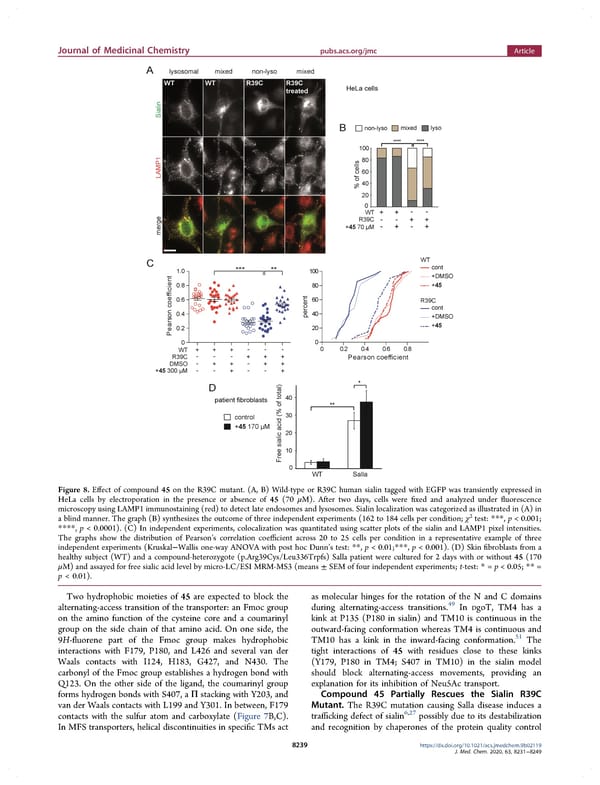Journal of Medicinal Chemistry pubs.acs.org/jmc Article Figure 8. Effect of compound 45 on the R39C mutant. (A, B) Wild-type or R39C human sialin tagged with EGFP was transiently expressed in HeLa cells by electroporation in the presence or absence of 45 (70 μM). After two days, cells were fixed and analyzed under fluorescence microscopy using LAMP1 immunostaining (red) to detect late endosomes and lysosomes. Sialin localization was categorized as illustrated in (A) in a blind manner. The graph (B) synthesizes the outcome of three independent experiments (162 to 184 cells per condition; χ2 test: ***, p < 0.001; ****, p < 0.0001). (C) In independent experiments, colocalization was quantitated using scatter plots of the sialin and LAMP1 pixel intensities. The graphs show the distribution of Pearson’s correlation coefficient across 20 to 25 cells per condition in a representative example of three independent experiments (Kruskal−Wallis one-way ANOVA with post hoc Dunn’s test: **, p < 0.01;***, p < 0.001). (D) Skin fibroblasts from a healthy subject (WT) and a compound-heterozygote (p.Arg39Cys/Leu336Trpfs) Salla patient were cultured for 2 days with or without 45 (170 μM)andassayed for free sialic acid level by micro-LC/ESI MRM-MS3 (means ± SEM of four independent experiments; t-test: * = p < 0.05; ** = p < 0.01). Two hydrophobic moieties of 45 are expected to block the as molecular hinges for the rotation of the N and C domains alternating-access transition of the transporter: an Fmoc group 49 In DgoT, TM4 has a during alternating-access transitions. on the amino function of the cysteine core and a coumarinyl kink at P135 (P180 in sialin) and TM10 is continuous in the group on the side chain of that amino acid. On one side, the outward-facing conformation whereas TM4 is continuous and 9H-fluorene part of the Fmoc group makes hydrophobic 51 TM10 has a kink in the inward-facing conformation. The interactions with F179, P180, and L426 and several van der tight interactions of 45 with residues close to these kinks Waals contacts with I124, H183, G427, and N430. The (Y179, P180 in TM4; S407 in TM10) in the sialin model carbonyl of the Fmoc group establishes a hydrogen bond with should block alternating-access movements, providing an Q123. On the other side of the ligand, the coumarinyl group explanation for its inhibition of Neu5Ac transport. forms hydrogen bonds with S407, a Π stacking with Y203, and Compound 45 Partially Rescues the Sialin R39C van der Waals contacts with L199 and Y301. In between, F179 Mutant. The R39C mutation causing Salla disease induces a 6,27 contacts with the sulfur atom and carboxylate (Figure 7B,C). trafficking defect of sialin possibly due to its destabilization In MFS transporters, helical discontinuities in specific TMs act and recognition by chaperones of the protein quality control 8239 https://dx.doi.org/10.1021/acs.jmedchem.9b02119 J. Med. Chem. 2020, 63, 8231−8249
 Amino Acids Bearing Aromatic or Heteroaromatic Substituents as a New Class of Ligands for the Lysosomal Sialic Acid Transporter Sialin Page 8 Page 10
Amino Acids Bearing Aromatic or Heteroaromatic Substituents as a New Class of Ligands for the Lysosomal Sialic Acid Transporter Sialin Page 8 Page 10